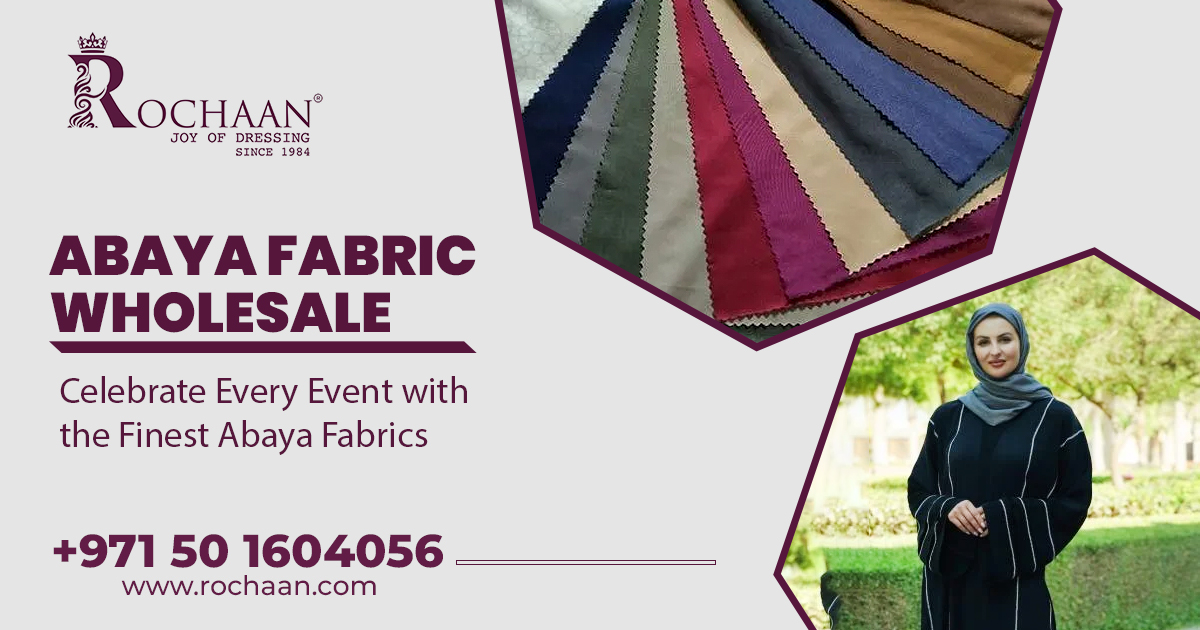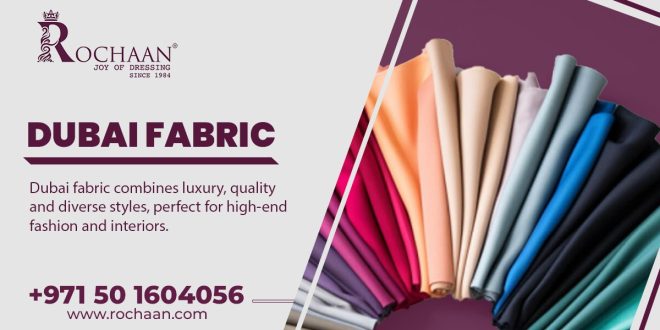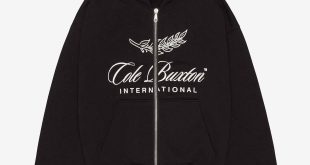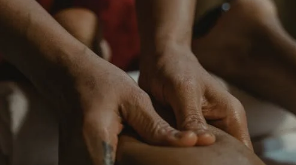Dubai, a hub of luxury, culture, and fashion, is known for its strong connection to traditional garments such as the abaya. The abaya, a long flowing cloak worn by women, holds deep cultural and religious significance in the UAE and across the Middle East. Over time, the design and fabric choices for abayas have evolved, blending tradition with modern fashion trends. If you’re in Dubai and looking for the best abaya fabrics, you’re in the right place. This guide will help you explore the different fabrics available in the market, their suitability for various occasions, and where to find the highest-quality materials.

1. Why Fabric Choice Matters in Abayas
The fabric of an abaya not only determines its appearance but also its comfort, durability, and appropriateness for different climates and occasions. In Dubai, where temperatures can soar during the summer months and cool down in the evenings, choosing the right fabric is essential for both practical and aesthetic reasons.
The material you choose can impact:
- Comfort: Light and breathable fabrics are better suited for Dubai’s hot climate.
- Elegance: Rich and luxurious fabrics like silk or velvet add a touch of class to formal abayas.
- Durability: High-quality fabrics ensure that your abaya lasts longer and maintains its structure and appearance over time.
Understanding the different fabric options will allow you to choose the best abaya for your lifestyle, climate, and personal preferences.
2. Popular Abaya Fabrics in Dubai
2.1. Nida
Nida fabric is one of the most popular choices for abayas in the UAE. Known for its softness, lightness, and elegance, Nida fabric offers a luxurious feel that is perfect for formal and everyday wear. Its matte finish gives it a classy, understated look, while its breathability ensures comfort in Dubai’s warm climate.
Features of Nida Fabric:
- Soft and lightweight
- Breathable and comfortable
- Available in various shades of black and other colors
- Ideal for daily wear and formal occasions
2.2. Crepe
Crepe is another highly favored fabric for abayas, especially for those looking for a lightweight and flowy material. Crepe has a slightly textured surface, which gives abayas a unique drape and structure. This fabric is often used for formal and semi-formal abayas due to its elegant appearance.
Features of Crepe Fabric:
- Textured surface with a matte finish
- Durable and wrinkle-resistant
- Lightweight and breathable
- Available in various weights (light crepe for casual abayas, heavier crepe for formal wear)
2.3. Satin
Satin abayas are ideal for evening wear and special occasions due to their luxurious and shiny finish. The fabric drapes beautifully, adding an air of sophistication to the garment. Satin, however, is not as breathable as some other fabrics, so it is better suited for cooler weather or indoor events.
Features of Satin Fabric:
- Glossy, smooth surface
- Luxurious and formal look
- Slightly heavier, making it less ideal for hot days
- Best suited for evening or special occasion abayas
2.4. Chiffon
Chiffon is a lightweight, sheer fabric that is often used as an overlay on abayas. It is commonly used for creating abayas with intricate designs or flowing sleeves. Chiffon abayas are perfect for special occasions or those looking for a delicate, feminine look.
Features of Chiffon Fabric:
- Lightweight and airy
- Sheer, often used as an overlay
- Delicate and elegant
- Perfect for layering and special occasions
2.5. Jersey
Jersey fabric is known for its stretch and comfort, making it a practical choice for everyday abayas. Jersey is a soft, knit fabric that provides a comfortable fit, ideal for those who prefer flexible, casual abayas. Its elasticity allows for freedom of movement, making it a great option for women who want something functional and stylish.
Features of Jersey Fabric:
- Soft, stretchy, and flexible
- Comfortable for everyday wear
- Durable and wrinkle-resistant
- Available in various weights for different climates
2.6. Linen
Linen is an excellent choice for abayas worn during the hot summer months. It is lightweight, breathable, and ideal for staying cool in Dubai’s scorching temperatures. Linen’s natural texture and casual appearance make it perfect for everyday abayas, especially during summer.
Features of Linen Fabric:
- Breathable and lightweight
- Perfect for hot climates
- Natural texture and casual appearance
- Slightly prone to wrinkling but ideal for comfort
2.7. Velvet
Velvet is a luxurious fabric often used for abayas designed for formal occasions or cooler weather. The rich texture and soft feel of velvet make it a favorite for winter abayas or evening wear. Velvet abayas exude opulence, and their heavier weight makes them perfect for layering during Dubai’s cooler months.
Features of Velvet Fabric:
- Soft, plush texture
- Luxurious and formal look
- Heavier weight, ideal for cooler weather
- Perfect for evening and winter abayas
3. Where to Buy Abaya Fabrics in Dubai
Dubai offers a range of places where you can find high-quality abaya fabrics, from traditional souks to modern shopping malls. Below are some of the top locations for fabric shopping:
3.1. Dubai Textile Souk
Located in Bur Dubai, the Dubai Textile Souk is a vibrant market offering a wide selection of fabrics, including those ideal for abayas. Here, you can find a variety of materials, from Nida to chiffon, at competitive prices. The Textile Souk is a great place to explore traditional fabrics while soaking in Dubai’s cultural heritage.
3.2. Satwa Fabric Market
Satwa is known for its bustling fabric stores that offer a range of textiles at affordable prices. Whether you’re looking for crepe, satin, or linen, Satwa has something for everyone. The market is also home to many tailors who can help create a custom abaya using your chosen fabric.
3.3. Dragon Mart
Dragon Mart, located on the outskirts of Dubai, is one of the largest trading hubs outside of China. This massive marketplace offers fabrics at wholesale prices, making it a go-to destination for those looking to buy abaya fabrics in bulk. The variety of materials available, from jersey to chiffon, ensures that you can find fabrics for both casual and formal abayas.
3.4. High-End Fabric Stores in Malls
For those seeking premium fabrics, Dubai’s luxury malls such as The Dubai Mall and Mall of the Emirates house high-end fabric stores. These stores offer designer textiles, including silk, French lace, and high-quality crepe, perfect for creating bespoke abayas for special occasions.
3.5. Online Fabric Stores
In addition to physical markets, several online stores in Dubai offer a wide range of abaya fabrics. Websites like Rochaan Fabrics specialize in abaya textiles, allowing you to browse their selection from the comfort of your home. Many of these online stores also provide customization services, so you can have your fabric tailored into an abaya of your choice.
4. Choosing the Right Fabric for Your Abaya
Selecting the right fabric for your abaya involves considering several factors, such as the occasion, climate, and personal style. Here are some tips to help you make the best choice:
4.1. Consider the Occasion
For formal events, opt for luxurious fabrics like satin, velvet, or silk that add a touch of elegance. For everyday wear, more practical fabrics like crepe, jersey, or Nida are ideal.
4.2. Think About the Climate
Given Dubai’s hot climate, fabrics like Nida, linen, and lightweight crepe are excellent for staying cool and comfortable during the summer months. Heavier fabrics like velvet or thick crepe are better suited for winter or indoor events.
4.3. Pay Attention to Durability
If you’re looking for an abaya that will withstand daily wear, choose a fabric like jersey or high-quality crepe that is durable and resistant to wrinkling.
4.4. Customization Options
Many fabric stores in Dubai also offer tailoring services. This allows you to choose your fabric and have it custom-made into a design that suits your style. Consider this option if you’re looking for something unique or tailored to fit perfectly.
5. Caring for Abaya Fabrics
Different fabrics require different care techniques to maintain their quality and appearance. Here are some general care tips for common abaya fabrics:
- Nida and Crepe: Hand wash or use a delicate cycle in the washing machine. Avoid high heat when ironing.
- Satin and Velvet: Dry clean for best results to preserve the texture and finish of the fabric.
- Jersey and Linen: Machine wash on a gentle cycle and hang to dry. Iron linen while it’s slightly damp to reduce wrinkles.
Conclusion
Dubai is a fantastic destination for finding the perfect abaya fabric. Whether you’re looking for something luxurious and formal or lightweight and practical, the city offers a diverse range of fabrics that cater to every need. From the bustling Textile Souk to high-end mall stores and online shops, Dubai provides an unparalleled shopping experience for abaya materials.
By understanding the different types of fabrics available and where to find them, you can choose the best material that not only suits your style but also ensures comfort and durability. Whether you’re crafting a special occasion abaya or an everyday garment, the fabric you choose will define the look, feel, and longevity of your creation.
 Diverse Perspectives: Insights & Stories Exploring Ideas, Sharing Knowledge
Diverse Perspectives: Insights & Stories Exploring Ideas, Sharing Knowledge





